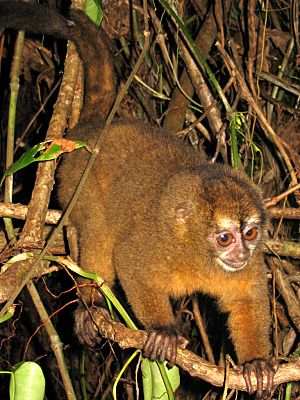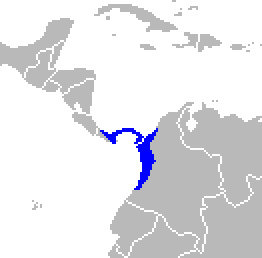Panamanian night monkey facts for kids
Quick facts for kids Panamanian night monkey |
|
|---|---|
 |
|
| Conservation status | |
| Scientific classification | |
| Genus: |
Aotus
|
| Species: |
zonalis
|
 |
|
| Distribution of Aotus zonalis | |
The Panamanian night monkey or Chocoan night monkey (Aotus zonalis) is a special kind of night monkey. It used to be thought of as a type of gray-bellied night monkey. These monkeys live in Panama and the Chocó area of Colombia. There are also some reports that they might live in Costa Rica, especially near the Caribbean coast. They are definitely found in the lowlands of Panama close to the Costa Rican border.
Scientists are still working to fully understand how the Panamanian night monkey is classified. Some experts believe it's a subspecies of the gray-bellied night monkey. However, a study by Thomas Defler in 2001 suggested it is its own separate species, A. zonalis.
Contents
About the Panamanian Night Monkey
The Panamanian night monkey is a fairly small monkey. Males usually weigh around 889 grams (about 31 ounces). Females are a bit heavier, weighing about 916 grams (around 32 ounces).
What They Look Like
Their fur can be grayish-brown to reddish-brown on their backs. Their bellies are a bright yellow color. A cool way to tell them apart from other "gray-necked" Aotus monkeys is their black or dark brown hair on the back of their hands and feet. Their hair is also shorter than other similar species.
Like all night monkeys, the Panamanian night monkey has very large eyes. This helps them see well in the dark because they are nocturnal, meaning they are active at night. However, unlike many animals that are active at night, their eyes do not have a special reflective layer called a tapetum lucidum. They also have a short tail compared to the size of their body.
Habitat and Lifestyle
The Panamanian night monkey spends most of its life in trees, which means it is arboreal. It is also the only type of monkey that is truly nocturnal. You can find these monkeys living in different kinds of forests. This includes forests that have grown back after being cut down, called secondary forest, and even in coffee plantations.
Social Life
They live in small family groups, usually with two to six monkeys. A group typically includes an adult pair, one baby, and a few younger monkeys. These groups are very protective of their homes. They have territories that only overlap a little bit with other groups.
Communication
Panamanian night monkeys use different ways to talk to each other. They use sounds, smells, and even body language.
Sounds and Smells
Scientists have recorded at least nine different sounds they make. These include various grunts, screams, squeals, moans, and trills. Males develop a special scent gland near their tail when they are about one year old. They use this gland to mark their territory with their unique smell.
Body Language
While sounds and smells are very important, they also use some body movements to communicate. For example, they might arch their back, jump with stiff legs, or make their fur stand on end.
Diet and Movement
These monkeys usually walk on all four legs when moving through the trees. But if they need to move quickly, they can also leap or run. They eat a variety of foods. One study on Barro Colorado Island in Panama found that their diet was mostly fruit (65%). They also ate leaves (30%) and insects (5%).
Reproduction and Life Cycle
Like other night monkeys, the Panamanian night monkey is one of the few types of monkeys that are monogamous. This means that a male and female pair stay together for a long time.
Family Life
The monogamous pair usually has one baby each year, though sometimes twins are born. The mother carries the baby for about 133 days before it is born. A very interesting fact is that the father carries the baby almost all the time from when it is just one or two days old! He only passes the baby to the mother for nursing.
Seeing Panamanian Night Monkeys
Many tourists enjoy seeing monkeys when they visit Panama. However, the Panamanian night monkey's habit of being active at night makes it harder to spot than other monkeys in Panama. But if you go with a skilled guide, it is possible to observe these unique night monkeys in their natural home.
See also
 In Spanish: Mico nocturno panameño para niños
In Spanish: Mico nocturno panameño para niños


